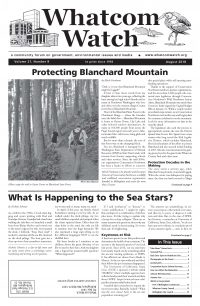by Peter Heffelfinger
The sun has finally kicked in, with midday temperatures in the 90s in the outside air, not to mention escalating readings inside a tall grow tunnel, where I struggle to keep crops cool by opening all the side vents and end doors. Fortunately peppers both hot and sweet love the warmth, and the tomatoes and cucumbers keep climbing as long as there is a steady watering. When it gets above 90 degrees Fahrenheit inside, however, tomato blossoms drop off instead of setting fruit. Tomatoes, being essentially ground vines, quickly recover, adding more flowers, especially if you leave a few extra suckers to take up the sudden blossom deficit. But the heat, uncommon until now in the Pacific Northwest, makes one focus on water supply and preventing soil dehydration.
A Paper Mulch Alternative
For years I have reluctantly used black plastic on my grow tunnel beds, to keep the soil moist and cool, as well also attracting solar radiation for a bit of reflected heat. A bit of a paradox, but it seems to work. This year I am experimenting with biodegradable paper mulch as an alternative to plastic. The roll was distributed via the Master Gardener Program at the WSU Extension, where Dr. Carol Miles is running mulch trials in a search for an alternative to plastic. The paper looks like slightly corrugated blotting paper, and soaks up water when splashed. So far the garter snakes accept it as a welcome place to hang out underneath, hopefully on duty versus slugs. We shall see how long it holds up before it becomes compost itself.
The campaign against plastic in the garden is quixotic, though. The grow tunnel itself uses high quality, UV-resistant plastic that has lasted 6–7 years so far, although we have started to take it off for the winter to prevent wind damage and any extra UV build-up. The arched pipes holding the cover up are, of course, heavy plastic; transplants large and small arrive in black plastic pots; the watering ‘cans’ are green plastic; and even the labels on the starts are white plastic tabs with pretty pictures printed on them. The 50-gallon rain barrels for storing water are stiff blue plastic, and the drip irrigation lines I am about to install are, of course, thin black snakes. The garden, like the world, runs on petrochemical by-products.
Paper mulch may be a small step, but at least it is a consideration as a possible alternative. The problem is that commercial black plastic ground cover is not recyclable, since recyclers will only accept it with 5 percent contamination. Short of carefully washing the plastic after use, farmers and gardeners can only toss it into the dumpster or garbage can, and hope that it will not eventually migrate to the ocean and break down into macro/micro/nano particles. The ocean life forms we depend on are dying due to plastic and other sources of pollution, as well as rising temperatures and acidification. The Modern Plague has arrived.
The Pre-Plastic Era
Growing up in the 1950s, food containers were cardboard and paper boxes, paper bags, waxed paper wrapping, cellophane and glass bottles. For carrying produce and large items there were Italian woven string/mesh bags that could expand to incredible size, as long as your arms were stout enough. Plastic soda bottles, plastic wrap, Styrofoam, plastic utensils, as well as plastic produce or garbage bags were in the all-too-soon future, along with a host of other petrochemical permutations such as PFAs, fire retardants and Teflon, etc. The Pre-Plastic Era seems a quantum jump back in time, where music was played on records using needles, letters were printed on paper with metal type, and all TV was live and in black and white.
Back to gardening. August is another transition month. Long-term fall and winter plantings should be heading up, such as Brussels sprouts, fall cabbages and long-term leeks. Look for starts of the winter variety of purple sprouting broccoli, which will reach full size before winter, then sprout in the early spring with welcome flowerets. For your winter greens, consider broccoli raab, a semi-hardy green that will keep flowering all winter under floating row cover, as well as fall turnips that are grown for the greens not the bulb, daikon radishes, and hardy Japanese scallions. And don’t forget collards, a sturdy Southern brassica that survives quite well up in our Maritime North.
Onions and Kin Year-Round
This year I am trying overwintering onions, started in early August in seed pots, then transplanted in the fall. They will hopefully survive the winter wet and head up as an early crop long before next spring’s regular onions are ready. The onion family is the one constant, year-round need in the kitchen: from early scallions, through fresh Walla Walla sweet onions, then onto stored onions and shallots, along with garlic bulbs safely sealed up in their white and purple skins. Not to mention chives, both the ordinary variety and the more hardy, perennial garlic chives. As a kitchen ritual, Step one in most any recipe is to chop/slice/dice an allium of some kind.
For mulch or compost in the garden, I rely on multiple worm bins, which are always overflowing from kitchen and garden scraps. I use 30-gallon metal or plastic (again) garbage bins, with holes punched in the bottom for drainage, securing the tops with bungee cords or rope versus rodents and dogs. I let the worms digest it all as the vegetable level works its way to the top of the bin. Once the worms are mostly at the uppermost surface, I scoop them off to work in a new bin. The remaining two-thirds of a bin of castings I put directly on the garden, either as a top dressing or working it in before planting. Inevitably there are still worms present in the mix, but I see the robins eagerly snatching them up as instant, fresh protein. Feed the birds, in the planting season at least, without having to buy bird seed or suet. Note: in the winter the special red wiggler worms, which are native to the South, retreat deep into the bin and form a ball against the cold. They do not survive in our Northern soil.
Field Day Research
Another WSU Extension note: I recently attended the annual Field Day in Mt. Vernon, where ongoing trials were on display, with short presentations by the researchers. Topics included: grafting as a means of introducing resistance to verticillium wilt; bulb fennel as a crop; scaling up cider apple orchard production; the use of bio-char compost; alternative cover crops; and pheromones to increase pollination of blueberries by honeybees. Many of the agronomy students were from China, Pakistan and India, a welcome sign of international co-operation in the face of global climate change, over-population, and the oncoming food supply crisis. One fact stood out: the Chinese researcher noted that the Skagit Valley now had a growing season the same as Sicily, a far cry from the norm in the 1970s, when our climate was similar to the cool summers of Northern Europe and the sheltered fields of England. I don’t expect to see wine grapes and olive trees growing here soon, but the field peas are long gone, and who knows how long the tulips will survive?
A final note: we had a taste of the first run of raw honey from the garden hives — very light in color with bits of honeycomb, not too sweet, and a perfect match for a buttery croissant.
__________________________________
Peter Heffelfinger, a Washington State University master gardener, has gardened organically on Fidalgo Island and the Skagit Flats for over 40 years. He has given workshops in year-round gardening for Transition Fidalgo/Eat Your Yard, Christianson’s Nursery, and at the Washington State University County Extension Service. He is a Salish Sea Steward, working on the invasive green crab survey.





























